Celeriac (Apium graveolens var. rapaceum)

About Celeriac
Celeriac, also known as celery root, is a lumpy, knobby root vegetable with subtle celery flavor and a smooth, starchy texture. It’s fantastic roasted, mashed, shredded raw into slaws, or simmered into creamy soups.
Despite its humble look, it brings earthy elegance and a slightly nutty sweetness — a true unsung hero of the root vegetable world.
The History of Celeriac
Celeriac was cultivated in the Mediterranean as far back as ancient Greece and Egypt, but it wasn’t eaten widely until the Middle Ages. It gained popularity in Northern and Eastern Europe, where it became a cold-climate staple.
It’s long been a favorite in French cooking — starring in celeri remoulade, a shredded raw salad tossed with mustardy mayo — and continues to be a key winter ingredient in many European cuisines.
The Science of Celeriac
Celeriac is rich in fiber, vitamin K, and phosphorus, with a low glycemic index. Its distinctive flavor comes from phthalides, the same aromatic compounds found in celery stalks.
When cooked, its starches break down into a silky texture — similar to a light potato but with a fragrant, herbaceous edge.
The Geography of Celeriac
Celeriac thrives in cooler climates and requires a long growing season. It’s cultivated in France, Germany, the Netherlands, the UK, and parts of the U.S. and Canada.
It stores well — lasting months in cold storage — making it a popular winter vegetable in northern countries.
Varieties of Celeriac
Prague Giant
A traditional European heirloom known for large roots and bold flavor. Great for mashing or roasting.
Brilliant
Smooth-skinned and uniform, with tender flesh and a mild flavor. Common in commercial production.
Monarch
Very round with firm texture. Popular in UK and French cuisine for its consistency in cooking.
Alabaster
Creamy-white flesh with minimal rootlets — ideal for raw applications like remoulade.
Tellus
A fast-growing Dutch variety with fewer crevices, making it easier to clean and prep.
FAQs All your questions about Celeriac: answered
Is celeriac the root of regular celery?
Not exactly. It’s a cousin of stalk celery, selectively bred for a large edible root.
Do you need to peel celeriac?
Yes — the skin is tough and knobby. A sharp knife works better than a peeler.
What does celeriac taste like?
Mildly nutty and sweet with a clean, celery-like aroma. It blends beautifully into purees and gratins.
Can you eat celeriac raw?
Yes — it’s delicious grated or julienned into slaws or dressed with lemon and mustard.